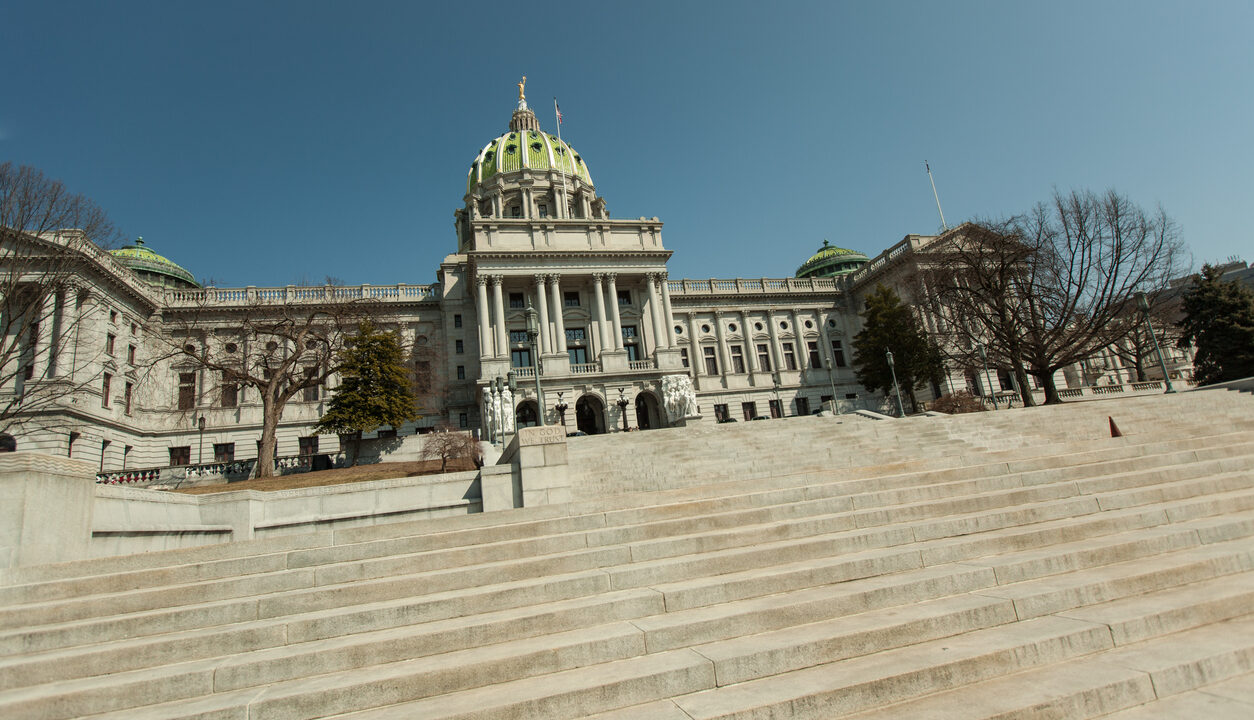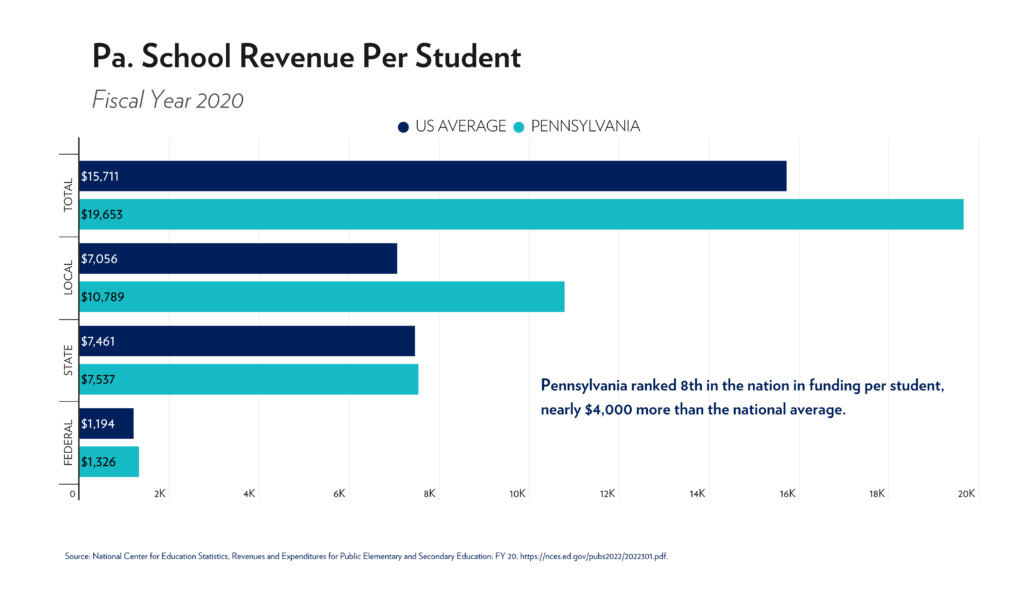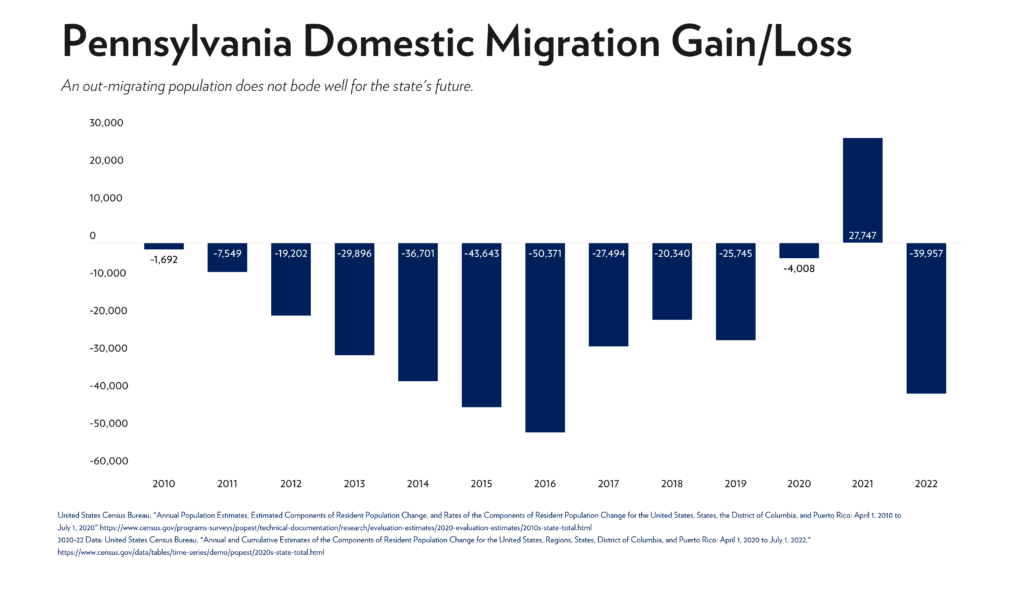Report

Key Takeaways from Gov. Shapiro’s 2023 Budget Address
Profligacy Exacerbates Budget Deficit
Gov. Josh Shapiro’s proposed budget calls for $45.9 billion in ongoing General Fund spending and $43 billion in net state revenues (after refunds). Thus, Pennsylvania has a deficit between ongoing revenue and projected spending of almost $3 billion.
While projections see the commonwealth starting the next fiscal year with a robust General Fund balance of more than $7 billion—essentially, the amount of money in the state’s checking account—that amount will dwindle due to deficit spending.
The Independent Fiscal Office (IFO) forecasts deficits for the next four fiscal years. At the current rate of spending and revenue growth, lawmakers will face a tax increase in 2026.
While now is the time to practice fiscal restraint by slowing the rate of spending growth and bringing the budget into balance, Shapiro proposes spending above IFO projections—exacerbating Pennsylvania’s structural deficit.
More Money Without More Opportunity Won’t Help Students
Shapiro proposes an additional $900 million for state support of public schools.
Unfortunately, the arguments Shapiro uses to justify this increase rely on myths of education funding.
State support of public schools is at an all-time high, after a record $1.5 billion increase in 2022 and a total increase of $4.7 billion during former Governor Wolf’s eight years in office. Pennsylvania ranks eighth in public school spending per student at nearly $20,000, or $4,000 more than the national average.
These never-ending increases in school funding—even as enrollment has dropped 6.6 percent since 2000—have allowed school districts to grow their reserves to an all-time high of $5.29 billion (as of July 2021), even while hiding reserve funds in order to raise taxes. In addition, the Treasurer shows $3.6 billion in unspent federal COVID funds yet to be distributed to school districts.
Shapiro called this spending increase a “downpayment,” but that’s a gross misuse of the term. A downpayment is a one-time payment that reduces monthly or annual costs. Shapiro’s plan is nothing like that.
Shapiro, like many taxpayer-funded lobbying groups—which, ironically, take money from the same school districts they claim are underfunded—justifies this increase with the recent ruling in the education funding lawsuit.
But that ruling did not order an increase in funding. Indeed, the court was explicitly “not convinced” by analysis claiming a multi-billion increase was needed. Rather, the court said “nor does it [this ruling] require reform to be entirely financial” and that “the options for reform are virtually limitless.”
More explicitly, the language that “the only requirement, that imposed by the Constitution, is that every student receives a meaningful opportunity to succeed” (emphasis in original) almost seems to guarantee educational choice to individual students. A student could not feasibly receive a “meaningful opportunity” if the only opportunity available to them is a chronically low-performing zip-code assigned school.
It would seem the only way to satisfy this requirement is for funding to follow the child to the educational option that provides the best opportunity for their specific needs.
Shapiro campaigned on support for a version of the Lifeline Scholarship program as well as continued growth in the Tax Credit Scholarship programs. His social media rhetoric emphasizes that no child should have their educational outcome determined by their zip code.
Yet his budget proposes no increase for Tax Credit Scholarships, does not include anything like the Lifeline Scholarship, and fails to provide for expanded educational opportunities.
While the Pennsylvania House delayed and dithered, three states (Utah, Iowa, and Arkansas) joined West Virginia and Arizona in offering universal education opportunity accounts, and similar legislation is moving in more than a dozen states.
School choice programs provide students with educational opportunity at a fraction of what public schools cost, saving taxpayers millions. Moreover, studies consistently show that educational choice improves the academic outcomes not only of scholarship students, but of those remaining in district schools, while academic research also finds fiscal benefits for school districts and taxpayers.
Pennsylvania can improve the quality of education, empower parents, and save taxpayers money—while competing with states leading the way—by expanding educational choice.

Missed Opportunity to Spur Economic Growth
Pennsylvania’s business climate remains uncompetitive, and the state continues to lose residents and businesses to more competitive states. According to CNBC’s “Top States for Business 2022,” Pennsylvania’s economy ranks 45th in the nation. Similarly, the American Legislative Exchange Council’s (ALEC) 2022 ALEC-Laffer State Economic Competitiveness Index ranks Pennsylvania 45th in Economic Performance.
As a result of this uncompetitive tax policy, businesses and workers are going elsewhere. Our commonwealth is seeing continual population loss from domestic outmigration.
Last year’s Corporate Net Income Tax (CNIT) reduction plan was an improvement, but Pennsylvania will remain uncompetitive for the foreseeable future. For years, Pennsylvania had a 9.99 percent corporate tax rate—the second highest in the nation. The reduction in January 2023 moved the commonwealth from 49th worst to 46th; the current phaseout would (every other state holding rates steady) put Pennsylvania at 15th by 2031.
Shapiro campaigned on cutting corporate taxes down to 4 percent by 2025 to make Pennsylvania “open for business,” an aggressive reduction that would give Pennsylvania one of the ten most competitive rates.
But his budget includes none of that.
Instead, Shapiro doubles down on Wolf’s unilateral (and likely illegal) energy tax. Candidate Shapiro expressed concerns about the Regional Greenhouse Gas Initiative (RGGI) and promised to “work with the legislature” on it—both the House and Senate voted in large, bipartisan majorities to block entry into RGGI.
But Shapiro’s budget includes $663 million in funds from RGGI—effectively a tax that will increase home electricity prices by 30 percent.
Rising energy prices are a top concern for Pennsylvania voters, who are struggling with increased cost of living, and looking for our elected leaders to work together with energy-producing companies to lower the cost of utility bills. Shapiro’s continued push for Wolf’s electric tax hike will only make matters worse.
Budget Ignores Dire Need for Medicaid Reform
Medicaid enrollment and spending have grown faster than our economy for over a decade. The program now covers about 3.6 million residents or nearly one-third of all Pennsylvanians. Medicaid is the largest program in the Pennsylvania state budget, and it consumes one-third of all state government spending.
Federal pandemic programs increased Medicaid funding to states—the 2022–23 revised budget uses more than $3.8 billion in federal dollars to offset state costs. In return for additional federal dollars, states are forbiddenfrom removing recipients from Medicaid rolls, even if their incomes exceed Medicaid eligibility, until April 1.
Pennsylvania’s Department of Human Services estimates over 500,000 Pennsylvanians enrolled in Medicaid are currently ineligible, while approximately 600,000 have not submitted information needed for redetermination of benefits.
The return to normal Medicaid redeterminations presents a rare opportunity to improve program integrity and ensure the commonwealth is preserving Medicaid for the most vulnerable. Unfortunately, Shapiro’s speech did not even mention Medicaid.
While the governor’s budget includes funding to serve another 850 individuals on the Medicaid waiting list for home and community-based services, there is no effort to promptly restore and increase the frequency of eligibility redeterminations or empower the more than 1 million healthy adults that qualify for Medicaid to work and regain independence.
The governor also calls for increasing food stamp benefits for low-income older adults and adults with disabilities, but ignores the need for restoring employment and training expectations for healthy adults.
A recent Commonwealth Foundation study showed that those in or near poverty want fewer barriers to employment and a path to prosperity.
Narrow Approach to Workforce Shortage won’t Reverse Pa.’s Employment Decline
Shapiro proposes new tax credits for new workers getting certification in select occupations—teachers, police officers, and nurses.
But such a narrow approach ignores a broader worker shortage that extends well beyond those occupations. Indeed, Pennsylvania industries (including manufacturing, transportation, food services, construction and energy) all report challenges hiring workers.
While the official unemployment rate is low, Pennsylvania has lost more than 100,000 workers since January 2020, with the labor force participation rate significantly below pre-pandemic levels. Currently, there are 1.72 job openings for every unemployed individual, the most since such tracking began. Further, the IFO estimates that the working-age population will decrease by 250,000 by 2025.
This trend is partly due to demographics—as Pennsylvania continues to lose working-age population moving to other states—and policies that disincentivize employment. Rather than targeted tax credits, Pennsylvania needs to look to comprehensive policies that encourage workers to return to employment—including reducing licensing barriers that restrict entry in occupations or prohibit professionals from other states working in Pennsylvania; reforming welfare programs that discourage work; and making Pennsylvania a more desirable state for families.
